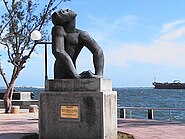User:Parker13125/Caribbean art
Influential Artists in the Caribbean
[edit]A Melting Pot
[edit]Art in the Caribbean has been influenced by its many different islands and their respective micro-cultures throughout the years. The identity of each island is unique and was shaped by a degree of different influences such as European Colonists, African Heritage, or Native Indian tribes.
The different islands and archipelagos provide a varying mix of ethnicities and cultures that helped shade contemporary art in the Caribbean today. "Caribbean art, and its production of paintings, drawings, prints, and sculpture, suggests an existence of different streams inside one big river."[1]
An issue plaguing artists in the Caribbean for a long time now is the lumping of the region in with the general Latin American region. The Caribbean has a wide array of cultures to be expressed and is only recently gaining traction as an independent region of contemporary art; This can be more broadly depicted by viewing the different periods of migration to the islands, first from the colonization of the islands, to the various European influences such as the Spanish, French, and English.
Despite the Caribbean Islands area a melting pot for contemporary art, the English-speaking islands have no museum devoted to contemporary art[2]. And thus, the Galleries of Jamaica have carved out space for the the entire regions collections and showcases. This has made the international views of contemporary art in the region feel more geared towards the Jamaican visions.
Artists
[edit]
Embracing African heritage is a focal point for a lot of contemporary art in the Caribbean Islands, and Manley is a key figure in the celebration of African heritage. She is mainly known for her sculpture depictions of black figures and is known as the, "Mother of Jamaican art."[1]
Manley was raised in England and attended the St. Martin's School of Art in London, with no intention of pursuing being an artist full time, she initially wanted to become a zoologist. She and her Husband moved to Jamaica in 1922. After moving, she realized the societal differences between the Jamaican and English middle-classes; this began to motivate and influence her politically and pushed her to address the issues that faced life in Jamaica. She began to push socialist ideologies and integrated this into her artwork, especially during times of civil unrest in Jamaica in the 1960s and 1970s. After her husband, Norman, passed away in 1969 Manley said that the thing that saved her was her art.[3] She began painting more due to her old age causing sculpting to become difficult. Eventually, Manley passed in February of 1987 at the age of 86.
Born in 1981 in Kingston, Jamaica - Ebony Patterson studied painting at the Edna Manley College of Visual and Performing Arts in Kingston, Jamaica and graduated in 2004. She then continued her education in the United States and received a MFA degree in 2006 from the Sam Fox School of Design and Visual Arts at Washington University in St. Louis. She is widely known for her colorful tapestries made out of unique materials.
A lot of her most recent work as been recognizing questions of identity and the human body. She expresses her work via various forms of media such as paintings, drawings, and collages. Patterson is frequently participating in art shows across the globe including the Baltimore Museum of Art, The Studio Museum in Harlem, Perez Art Museum Miami, Speed Art Museum in Louisville, KY. She has plans to travel internationally and continue to attend art shows. She is young and continues to inspire artists around the world and showcase the unique culture of art that stems from the Caribbean area.
Maksaens Denis[5] is a video and installation artist of Caribbean new media art; Born in 1968 in Port-au-Prince. He derives strong influences from classical and experimental music and concerns his work with an intersection of performance, spirituality, queerness, and politics.
Imagery is an integral part of Denis' art and he blends images of everyday life in Haiti into his artwork. He also commonly depicts the historical processes that shape the identity of black atlantic subjects. He is currently living in working in Port-au-Prince and continues to derive video installations that express the culture of the region.
- ^ a b "What Do We Know About Caribbean Art ? | Widewalls". www.widewalls.ch. Retrieved 2020-10-13.
- ^ "Caribbean artists step into the spotlight". www.theartnewspaper.com. Retrieved 2020-11-12.
- ^ Lim, Caryn (2017-07-14), "Being 'mixed' in Malaysia", Mixed Race in Asia, Routledge, pp. 117–131, ISBN 978-1-315-27057-9, retrieved 2020-10-13
- ^ "Ebony G. Patterson: …when the cuts erupt…the garden rings…and the warning is a wailing…". Contemporary Art Museum St. Louis. 2019-09-18. Retrieved 2020-10-28.
- ^ González, Julián Sánchez (2019-07-25). "12 Artists of the Caribbean and Its Diaspora Who Are Shaping Contemporary Art". Artsy. Retrieved 2020-10-28.
